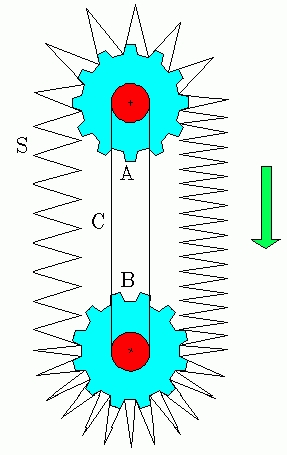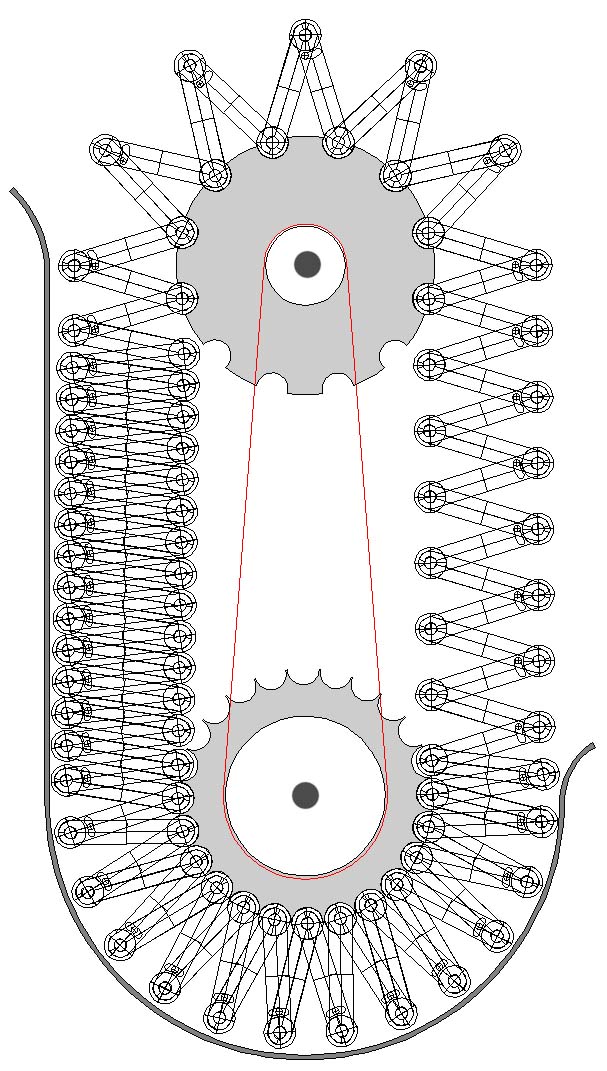
Simanek's Silly Slinky Device
solutions and discussion.
This device elicits reactions such as "That's a dumb idea!" Granted, but it's a clever and devious dumb idea. After all, every perpetual motion design is a flawed idea. This one just looks different from any I've seen in the literature and any that have ever been patented. But it employs classic "principles" of many classic perpetual motion machines. It is continually unbalanced; there's more weight on the right side, and presumably more torque on the spring coils on the right. Solution 1: After moving the pulley by hand, the new position of the system is identical in every way to the previous state, and the potential energy of the system in any position of rotation through a multiple of 2 teeth is exactly the same. So the system does no work. This is an application of Stevin's principle.
Solution 2: The force the expanded spring exerts on the gear at the top is twice the downward force exerted by the compressed spring on the other side. Hooke's law: F = -kx. So the downward forces on the left and the right of the pulley are equal, and the net torque on the upper gear is zero. Therefore that pulley will not accelerate.
Solution 3: The tension in the coils on the right is half that on the left. But there are twice as many coils on the right. So the work gained as coils fall on one side is equal to the work required to lift those coils back up on the left. Net zero.
Solution 4: The center of mass of the device is constant, never rising above the top axle, never falling.
Solution 5: The torque on the upper gear due to the timing belt exactly counters the torque due to the imbalance of the spring coils. This is probably the simplest observation that tells us this idea is a non-starter.
It's obvious that the work in carrying coils over the top pulley is zero, and likewise on the bottom pulley.
The above two solutions tell us that the gear wheels initially at rest will remain at rest. So work doesn't come into the picture. Now if we wish, for fun, to consider the system set in motion by giving it a push, what's the situation during rotation?
Solution 3 restated: The vertical segments have masses in ratio 2:1. But if we manually turn the system, when the heavy side moves down (for example) a certain distance Y, the lighter side moves up a distance 2Y, by geometry. This is ensured by the chain belt connecting the two pulleys, the pulley diameters, and by the peculiar way of stringing the spring over the gear teeth. It constrains the velocity of the spring to be constant on both sides. Therefore the work done by gravity in moving one side down is exactly equal to the work against gravity to move the other side up.
What about the work done in compressing and expanding the spring during motion? Again, the two are equal during any cycle, and there's no net work done by this process.
Observation: If a mass of chain, m, moves up at speed v on the left, for continuity of motion a mass 2m must move down at speed v/2 on the right. So the momentum of chain on the left is mv (upward) and the momentum of chain on the right is (m/2)v = mv (downward). So conservation of momentum is satisfied, as well as conservation of energy. All is well with the laws of classical physics.
This raises the question. If friction and dissipative processes were eliminated, would this, given a push, continue turning with constant speed? Yes, but so would a simple flywheel.
This is yet another unworkable device that has unbalanced mass, yet the mass and velocity on opposite sides of the axle are in inverse proportion, and therefore their product is the same. The result is that the change in potential energy on one side is equal and opposite to the change in potential energy on the other side. For the complete cycle the net change in potential energy is zero. Therefore the device will not move on its own, and because of friction, will not sustain any motion given to it by a push. Other examples in this museum incluing Patrick Voet's Perpetuum Mobile and Murilo Filo's avalanche drive, both found in the New Acquisitions gallery. Many other examples are found in the patent literature.
Some may choose to do a force analysis on the segments of the Slinky spring. This requires care in isolating portions of the system, but you will find that each part of the system is in force equilibrium. A torque analysis is more interesting. Take torques about, say, the center of the top pulley. The torque due to gravity acting on the heavier spring segment is twice that of the lighter segment. Is the net torque on the spring zero? Of course, for just as the tensions are not equal in the two vertical portions of the Slinky, the tensions are also not equal in the two portions of the inner belt (or chain).
A very perceptive reader complained that the first picture of this device had a deliberate extra deception. Well, that's one common theme in this museum. He noticed that the pulley ratio of 2:1 and the trick of stringing the slinky so that it has one loop per tooth on the upper gear and two loops per tooth on the lower gear exactly compensate each other, and both are entirely unnecessary. He admitted these features were clever, but useless. This puzzle was in the museum for two years before anyone noticed that! Yes, we confess. It was deliberate. I thought the puzzle would be "too easy" if I had identical gears with the spring equally strung over them, and the belt running over sheaves of equal diameter. In fact, the original design didn't have a belt, but a smaller idler wheel between the two pulleys. When this distraction is stripped away it is all too obvious that the key to this device is simply the constraint that forces the spring to remain "bunched up" continually on one side of the upper axle, achieving the age-old goal of the perpetual motionists—continual overbalance. Too bad that continual overbalance doesn't initiate or sustain motion. One part of the system (the spring in this case) may be overbalanced, though the system is not.
Another distractor built into this puzzle was the use of the light (Slinky ™) spring. This gets people to wondering whether forces involved in the stretching and relaxing of the spring might play a role. They don't. The work done in stretching the spring is equal and opposite to the work the spring does when relaxing. But dissipative forces in this process would waste energy—if the thing were turning. But it doesn't turn by itself.

Evolution of the idea.
The first version of this device didn't have a belt. It had an idler gear slightly smaller than the other two, and between them. Only a pencil sketch was ever made.The second version (shown at right) had a belt over equal radius pulleys. The 2:1 ratio was achieved by doubling up the spring loops in each gear tooth gap. This was because I was too lazy to make two different gear drawings.
Now [July 2011] artist/inventor Oldrich Nos sends me his "improved version". I show it full size because it is a magnificent artwork.
 |
| Drawing ©: by Oldrich Nos. |
|---|
|
By using a chain of links, any energy losses due to spring flexing are eliminated. A clever pin in slot mechanism near the outer hinges limits how far adjacent links can spread apart on the right. Geometry of the chain and lower gear limits their minimum separation on the left. Oldrich includes a shield to prevent the chain from losing contact with the bottom wheel from its own weight. [In the Slinky version the spring's natural tension was supposed to prevent that.] Some inventors use gravity latches in such situations. For example, see Murilo' Filo's Murilo Filo's Avalanche Drive. In fact, Oldrich has morphed my Silly Slinky idea into something very close to Murilo's chain. There are differences, though. My slinky idea and Oldrich's version both require the "timing belt" linkage. Murilo's device uses gravity latches and a shield to keep the lower part of the chain on track and maintain the 2:1 chain compression ratio. That is mechanically clever. But neither method works to initiate or sustain motion, or, one might say, they work equally well—not at all.
This reminds me that it has been some years since Murilo Filo promised he would build a working model of his avalanche drive. I haven't heard from him since, and there's been no announcement in the press. But Murilo continues on various web forums to declare that his avalanche drive works (on paper), and to vilify me by name as having a brain cast in cement. I should thank him for publicizing my web site and giving it a wider audience.
Return to front page.
Return to the top of this document.
Return to the Museum's main gallery.